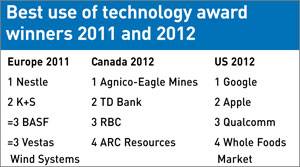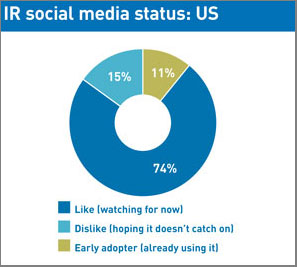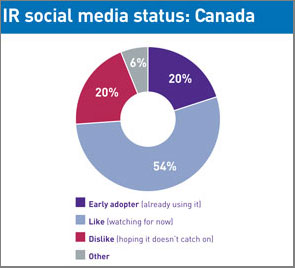The companies that make the best use of technology for IR have come a long way in a short time
Nestlé launched its first IR video blog in April this year. The occasional posts, currently averaging one a month, star head of investor relations Roddy Child-Villiers standing in front of a typical Swiss mountain view.
He addresses investors for a little over a minute about upcoming announcements and IR-related events while drinking various company products. In April it was milk; in May he was holding what looked like sparkling water.
Aside from projecting the healthiness of IR life in Switzerland, the videos prove that three years is a long time not only in technology as a whole but also in the history of IR magazine’s award for best use of technology, handed out on a Europe-wide basis annually since 2010.
When Nestlé won its first best use of technology award that same year, a bemused Child-Villiers got up on stage at the London Hilton on Park Lane brandishing a new iPad; Apple had released the first iPad in western Europe only a month earlier and has since sold more than 15 mn units before releasing the iPad 2. ‘We hadn’t thought of ourselves as being leading-edge users of technology,’ Child-Villiers later told IR magazine.
A year later Nestlé won the award again, by which time each member of the team had been issued with an iPad, presumably to look at the new investor relations app, which when shaken brings up the current Nestlé share price. ‘This year, we feel like we have done something a little bit more leading edge,’ Child-Villiers observed when he spoke to IR magazine for the Investor Perception Study, Europe 2011.
To tweet or not to tweet?
At that time, Child-Villiers was wrestling with the idea of social media for IR. He took a personal interest in its development, participating in debates on the topic, but doubted its added value for investor relations. On balance, he thought there was little value in tweeting abridged versions of the chairman’s letter.
Twelve months later he and his team are churning out tweets, ranging from at least one a week since October 2011 to nine times in a day on April 2, 2012, the day the company announced the acquisition of the baby nutrition unit from US drug giant Pfizer.
For that deal alone, Child-Villiers tweeted links to the press release and multiple tweets about a deal-specific audio webcast of an investor call with senior management, followed by responses to media inquiries about the availability of the recording and a prompt that the presentation had been put on SlideShare.
As of May 25, Nestlé IR had 206 followers on Twitter, up from 202 a few weeks earlier, mostly made up of other Nestlé businesses, food distributors and sellers, media professionals, services companies such as lawyers and accountants – and perhaps the odd chocolate fanatic.
Today, the Nestlé IR team ticks almost every box when it comes to technology use for IR. The IR app is now available for Android and it has been downloaded more than 1,000 times since its launch; 21 reviewers give it an average rating of four out of five stars. The Nestlé IR website, optimized for mobile use and most recently updated in April this year, has webcasts from the full-year results roadshow at the London Stock Exchange, lasting close to two hours. For the more time-challenged, there is a video entitled ‘The Pfizer acquisition in three minutes’, which is essentially jazzed-up PowerPoint slides set to spa music. There is an interactive annual report, too.
Just to show it’s not all style over substance, however, the first button on the IR website prioritizes the financial overview of the company, giving the group operating figures and balance sheet in a user-friendly, easy-on-the-eye format, as well as breaking them down by region and product line.
‘We thought investors and analysts were not looking for leading-edge users so much as they were seeking companies that provided a good working interface for them to use,’ observed Child-Villiers last year. Arguably, Nestlé now delivers both.
Give them what they want
During IR magazine’s discussions with award-winning IROs from across the world for the investor perception studies in Europe, Asia, the US and Canada, the collective approach to technology use can best be described as investor-led. Essentially, IROs have been saying, ‘Until investors ask for it, we are not going to offer it.’ Social media are a particularly salient example of this: only last year Twitter-dedicated Child-Villiers observed how no one in the investment community was complaining about his IR team’s lack of a social media presence.
What’s more, when the IR teams in the US Top 100 and Canada Top 50 were asked to describe their social media status, the majority in both countries said they were ‘watching for now’ – essentially waiting for demand to necessitate supply (see IR social media status: US & Canada, below). The IR leaders in Asia were the most reticent of all. 

To some extent they all had a point. IR magazine isn’t seeing any demand from the thousands of investors surveyed for our awards and investor perception studies. Not one investor or analyst mentioned social media to our researchers in any of those regions. Well, not until now, at least.
This year, four firms in Europe are specifically singled out for their IR social media presence: Nestlé, Novartis, Burberry and Tullow Oil. This is, admittedly, only a small number, even within the context of the Euro Top 100 – our ranking of the best IR practitioners in Europe – but it is four more than last year and every year before that.
It is perhaps worth remembering at this point that at the start of 2010 nobody was asking for the iPad to be invented, or even needed it. Fast forward two years, however, and there are some who could not live without it.
Adoption on the rise
The uptake of apps and social media in the IR world may be slightly slow compared with the real world, yet if the best in technology award we hand out is anything to go by, the pace of adoption is picking up. After all, it was only two years ago when the six firms on the short list for best use of technology in Europe were being commended just for their websites.
Since then, the leading-edge IR teams in Europe have been pushing technology forward, year on year, as the Nestlé case study shows. Winning the award for best use of technology in 2010 may have initially come as surprise to Child-Villiers, but on June 26, 2012, at the IR Magazine Europe Awards in London, Nestlé will again be competing to win the best in technology award for the third year in a row, going up against BASF, Unilever and Santander – something else for the IR team to tweet about.










